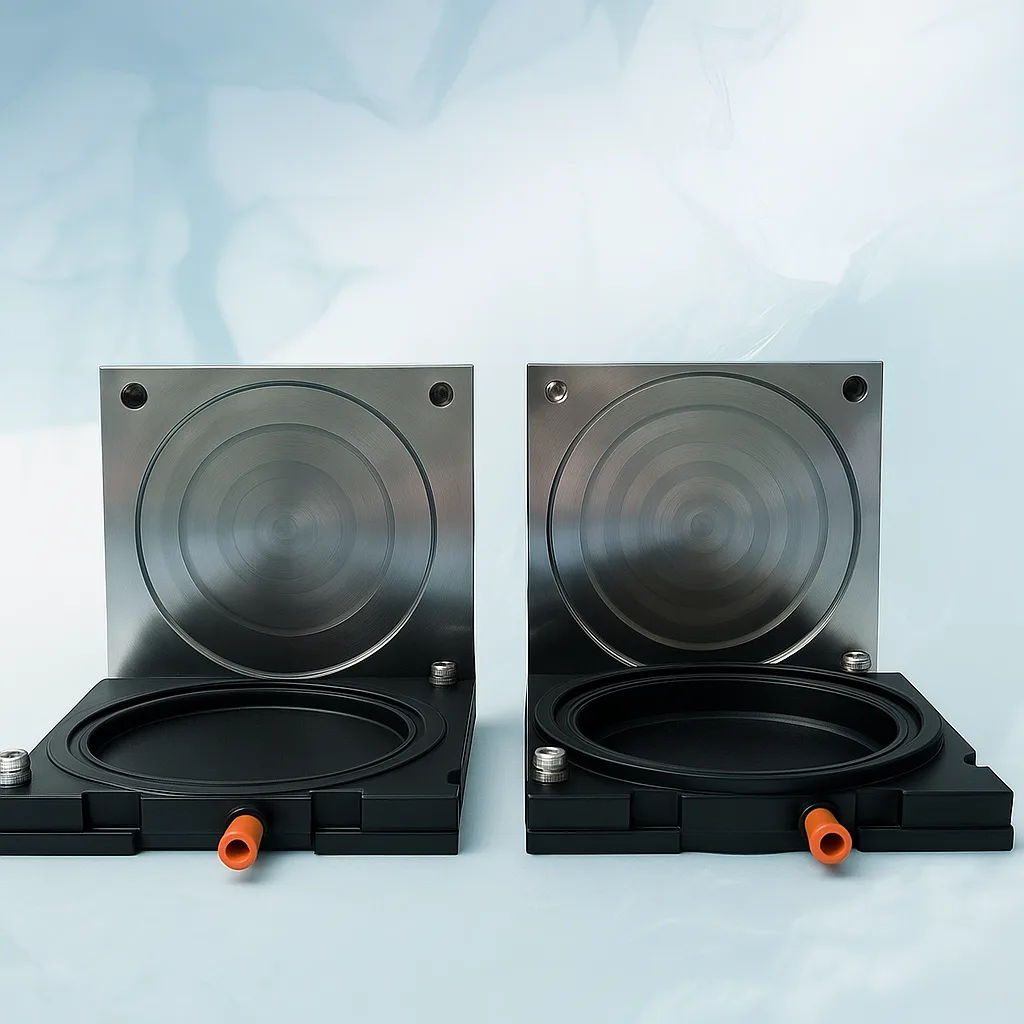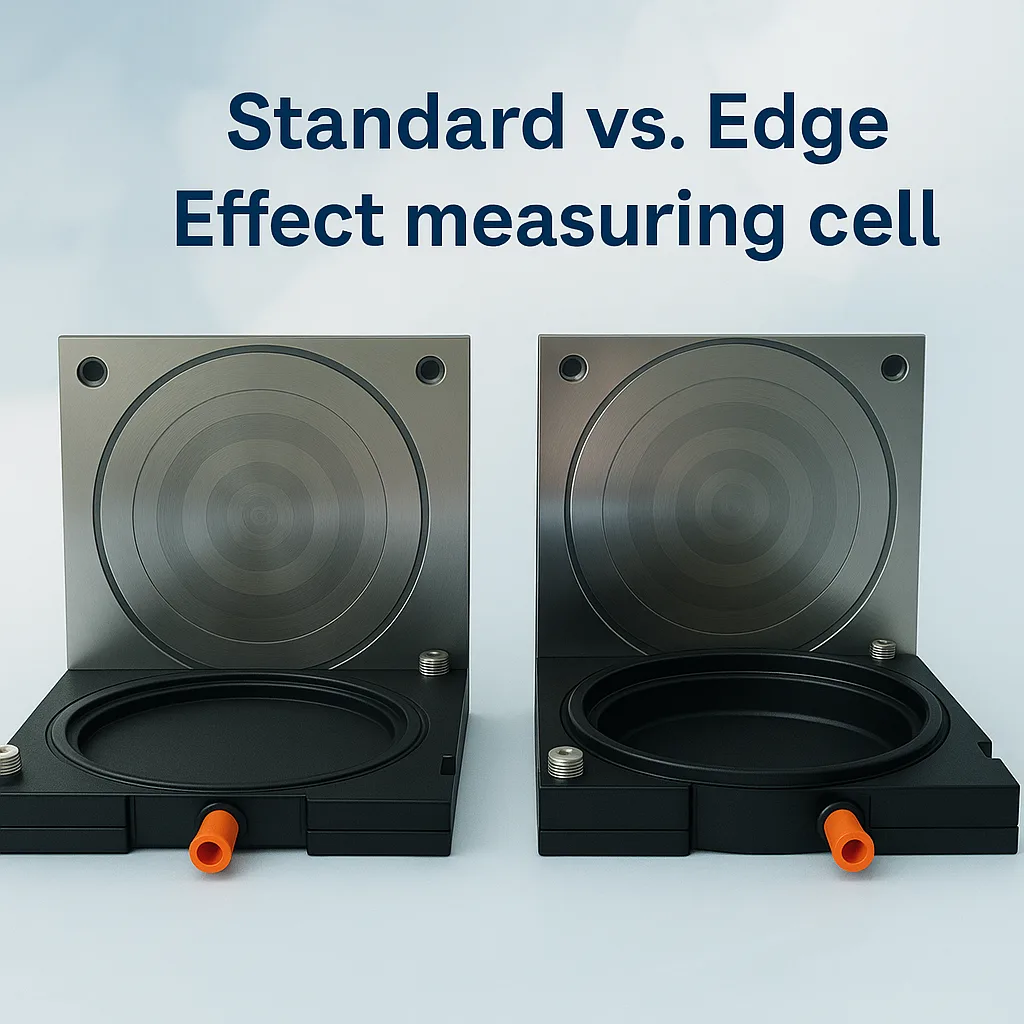Packaging materials often need to act as a barrier against oxygen (O₂) and water vapour (moisture) to keep food fresh and ensure a long shelf life. The permeation rate (OTR for oxygen transmission rate and WVTR for water vapour transmission rate) indicates how much gas diffuses through a material. These rates can be determined precisely using special testing instruments, such as the MOCON (Ametek) permeation testers. The film or packaging to be tested is clamped into a measuring cell that separates two chambers (one side with a high gas concentration, the other one with an inert carrier gas). This allows the amount of O₂ or H₂O that penetrates the material per unit of time to be measured.
Standard measuring cells vs. edge effect measuring cells

In practice, different types of measuring cells are used. On the left side of the image, you can see a standard measuring cell, and on the right side, an edge effect measuring cell (here from Mocon Ametek). Both serve the purpose of tightly enclosing the sample, but differ in design and performance:
- Standard measuring cell: Here, the sample is clamped flat between seals (e. g. an O-ring). This proven design delivers reliable results for homogeneous plastic films.
Challenge: With certain materials – such as coated papers or fibre-based composites – leaks can occur at the edges of the samples. The reason: gas can penetrate the measuring area from the side through porous structures or uneven edges if the film does not lie completely flat everywhere. This phenomenon, known as the “edge effect”, leads to inhomogeneous sealing surfaces and falsified measurement results, as additional oxygen/water vapour can penetrate around the sides of the sample. Standard measuring cells are therefore less suitable for such materials – the measurement results would indicate an excessively high permeation rate, even though the centre of the film is actually denser than the edge. - Edge effect measuring cell: To prevent these edge leaks, MOCON Ametek has developed special edge effect measuring cells. Design features include a raised edge and additional seals that completely and homogeneously seal the sample perimeter. This “dam” construction (dam structure) shields the edges from the ambient air. A TruSeal® purge ring is often used: inert gas is fed between two seals, immediately purging any oxygen or moisture that may have penetrated from the edge area. In this way, the edge effect is effectively eliminated by sealing the sample edges during the test and preventing O₂ or H₂O from penetrating from the outside. The result: uniform sealing surfaces without leak paths and thus significantly more stable, more precise measurement results. Background permeation (zero value) decreases, making even the slightest permeabilities more accurately detectable. In short, such edge effect cells enable accurate and reproducible measurement of oxygen and water vapour permeability even for materials with inherent edge leakage (e. g. coated paper composites).
Innoform Testservice – Your specialist for permeation measurement
As an independent testing laboratory, Innoform Testservice offers accredited testing methods for OTR and WVTR – we use the appropriate measuring cells depending on the material and the issue at hand. Our laboratories are equipped with modern MOCON OX-TRAN and AQUATRAN systems, enabling us to use both standard measuring cells for common film tests and edge effect measuring cells for demanding materials. This ensures that you always receive reliable measurement results for the oxygen and water vapour permeability of your packaging. Innoform is your expert partner for all aspects of barrier testing and will be happy to advise you on selecting the appropriate test method.
Note: All measurements are performed in accordance with international standards (e. g. ASTM D3985 for O₂ and ASTM F1249/ISO 15106 for H₂O) and under controlled conditions to ensure the comparability and quality of the results.
Conclusion: With our expertise and the right measurement technology – whether standard or edge effect – we help to evaluate the barrier properties of packaging in a well-founded manner.
Contact: Dr. Daniel Wachtendorf, +49 441 94986-22
Click here to access our free online permeation calculator. A tool for anyone who wants to calculate the permeation properties of barrier films theoretically first.

